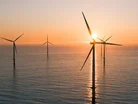McKinsey: Accelerating the Net Zero Transition Amid Hurdles

Recent findings by the McKinsey Global Institute (MGI) shine a stark light on the net zero journey, revealing that a mere 10% of the crucial physical assets needed for a sustainable future are currently in place.
This calls for a rapid escalation in efforts, as the energy shift needs to move from ideation to tangible implementation.
The immense undertaking of energy transformation
In an engaging turn of focus, MGI Senior Fellow Tiago Devesa articulates the institute's fresh perspective by delving into the concrete requirements of the future energy framework.
He said: “We wanted to flip the paradigm in this report and focus on the physical realities — the nuts and bolts — in the here and now. What are the technologies, supply chains and infrastructure we need to run the high-performance low-emissions energy system of the future?”
“The more I work on this topic, the more I am fascinated by how — while we can often talk about individual technologies, sectors, companies or countries — at its core, what we are talking about is a system-wide transformation,” Mekala concluded. “I go back to our metaphor: we are not replacing the bulb, we are rewiring an entire house.”
MGI's comprehensive study orbits around seven pivotal areas needing physical overhaul, spanning an expansive terrain consisting of power generation, industrial operations and transportation.
This domain envelops an extensive array of facilities and infrastructure, counting 60,000 power stations, more than 1.5bn vehicles, and two million kilometres of oil and gas pipelines. The research team identifies 25 fundamental barriers classified according to three tiers of difficulty.
Despite witnessing a surge in renewable energy sources, electric vehicles (EVs), and heat pump technologies, the survey uncovers a hard truth: only about 10% of the necessary physical assets for fulfilling 2050's global sustainability pledges have been set in motion.
“This is not an abstract dollar number, goal or theoretical pathway,” he added. “It’s the physical world that exists around us today. So, despite all the momentum, we’re still in very early stages of the energy transition."
Can we achieve energy transition milestones?
Analysing the chasm that is the remaining 90%, McKinsey discerns an evenly split challenge landscape.
MGI Partner Mekala Krishnan, steering this research, said: “Half of the energy system-related emissions are in what we call Level 1 and Level 2 challenges — things that are relatively easy to solve. It’s a matter of how to best deploy mature technologies. But the remaining 50% are what we call Level 3 — the harder challenges.”
These formidable barriers manifest predominantly in sectors such as hydrogen fuel production, carbon capture and high-scale industrial activities, where present adoption starkly trails the requirements for a net zero future.
“We’re sometimes at 1% deployment or even less of where we will eventually need to be,” she said.
“For example, many of the technologies to produce low-emissions steel are relatively nascent, with issues to solve. Then there is the challenge of scaling any new technology: we would need to retrofit massive facilities processing millions of tons of steel around the world.
Then there is the challenge of scaling any new technology: we would need to retrofit massive facilities processing millions of tons of steel around the world
“Third, we need to solve the adjacent problem of accessing enough low-emissions hydrogen and power and their respective value chains — inputs that are needed for the manufacturing of decarbonised steel.
“This illustrates what makes this work hard. We see this in cement, in plastics, in ammonia: the consistent theme of technology performance gaps, massive scaling needs and entwined linkages.”
The conversation shifts towards optimism as Tiago underscores the potential in tackling 'Level 1' challenges to hasten progress. He spotlights the significant impact of current EV models in meeting the needs of a vast majority of households and the capability of air-source heat pumps to cater to 95% of the global population's heating and cooling demands.
He said: “The average electric car being sold today can cover the needs of more than 70% of households and high-end models more than 90%. There’s still work to be done, but we’re close there. Another example is air-source heat pumps, which can serve the needs of over 95% of the human population no matter where they live.
“This is encouraging because these are two of the foundational technologies that we need to decarbonise mobility and buildings.”
Key insights from MGI's energy transition exploration
The road to an energy-efficient future involves a comprehensive system overhaul, necessitating strategic foresight from all sectors.
Mekala underscores this point by advocating for a holistic review of the enterprise, industry and global energy dynamics to effectively navigate the transition.
- Based on Level 1 challenges which are relatively easy to address, what initiatives can I take today that will have an impact?
- For so-called Level 2 challenges, where there are constraints to scaling, where do I expect there to be bottlenecks or hurdles in the medium-term and how do we prepare for these?
- For Level 3, can we play a role here? Where is the potential to create value for our business? Where do we need to innovate on individual technologies and form strategic partnerships to help solve some of them?
“The more I work on this topic, the more I am fascinated by how — while we can often talk about individual technologies, sectors, companies or countries — at its core, what we are talking about is a system-wide transformation,” Mekala concluded. “I go back to our metaphor: we are not replacing the bulb, we are rewiring an entire house.”
******
Receive the next edition of ClimateTech Magazine by signing up for its newsletter.
As part of this portfolio, make sure you check out Sustainability Magazine and also sign up to our global conference series - Sustainability LIVE.
Also check out our Sister Brand, Energy Digital.
******
ClimateTech Digital is a BizClik brand.

